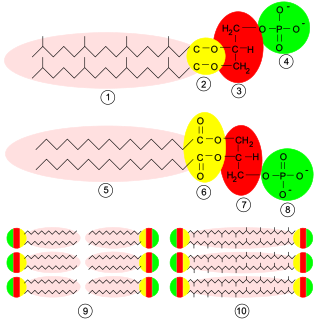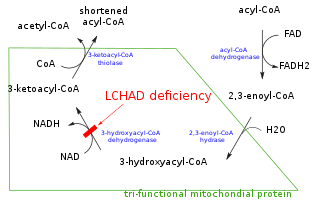
In chemistry, particularly in biochemistry, a fatty acid is a carboxylic acid with an aliphatic chain, which is either saturated or unsaturated. Most naturally occurring fatty acids have an unbranched chain of an even number of carbon atoms, from 4 to 28. Fatty acids are a major component of the lipids in some species such as microalgae but in some other organisms are not found in their standalone form, but instead exist as three main classes of esters: triglycerides, phospholipids, and cholesteryl esters. In any of these forms, fatty acids are both important dietary sources of fuel for animals and important structural components for cells.

A triglyceride is an ester derived from glycerol and three fatty acids. Triglycerides are the main constituents of body fat in humans and other vertebrates, as well as vegetable fat. They are also present in the blood to enable the bidirectional transference of adipose fat and blood glucose from the liver, and are a major component of human skin oils.
Essential fatty acids, or EFAs, are fatty acids that humans and other animals must ingest because the body requires them for good health, but cannot synthesize them.
A saturated fat is a type of fat in which the fatty acid chains have all single bonds. A fat known as a glyceride is made of two kinds of smaller molecules: a short glycerol backbone and fatty acids that each contain a long linear or branched chain of carbon (C) atoms. Along the chain, some carbon atoms are linked by single bonds (-C-C-) and others are linked by double bonds (-C=C-). A double bond along the carbon chain can react with a pair of hydrogen atoms to change into a single -C-C- bond, with each H atom now bonded to one of the two C atoms. Glyceride fats without any carbon chain double bonds are called saturated because they are "saturated with" hydrogen atoms, having no double bonds available to react with more hydrogen.
An unsaturated fat is a fat or fatty acid in which there is at least one double bond within the fatty acid chain. A fatty acid chain is monounsaturated if it contains one double bond, and polyunsaturated if it contains more than one double bond.

Glycerophospholipids or phosphoglycerides are glycerol-based phospholipids. They are the main component of biological membranes. Two major classes are known: those for bacteria and eukaryotes and a separate family for archaea.

In biochemistry and metabolism, beta oxidation (also β-oxidation) is the catabolic process by which fatty acid molecules are broken down in the cytosol in prokaryotes and in the mitochondria in eukaryotes to generate acetyl-CoA, which enters the citric acid cycle, and NADH and FADH2, which are co-enzymes used in the electron transport chain. It is named as such because the beta carbon of the fatty acid undergoes oxidation to a carbonyl group. Beta-oxidation is primarily facilitated by the mitochondrial trifunctional protein, an enzyme complex associated with the inner mitochondrial membrane, although very long chain fatty acids are oxidized in peroxisomes.

Medium-chain triglycerides (MCTs) are triglycerides with two or three fatty acids having an aliphatic tail of 6–12 carbon atoms, i.e. medium-chain fatty acids (MCFAs). Rich food sources for commercial extraction of MCTs include palm kernel oil and coconut oil.
In biochemistry, fatty acid synthesis is the creation of fatty acids from acetyl-CoA and NADPH through the action of enzymes called fatty acid synthases. This process takes place in the cytoplasm of the cell. Most of the acetyl-CoA which is converted into fatty acids is derived from carbohydrates via the glycolytic pathway. The glycolytic pathway also provides the glycerol with which three fatty acids can combine to form triglycerides, the final product of the lipogenic process. When only two fatty acids combine with glycerol and the third alcohol group is phosphorylated with a group such as phosphatidylcholine, a phospholipid is formed. Phospholipids form the bulk of the lipid bilayers that make up cell membranes and surrounds the organelles within the cells. In addition to cytosolic fatty acid synthesis, there is also mitochondrial fatty acid synthesis (mtFASII), in which malonyl-CoA is formed from malonic acid with the help of malonyl-CoA synthetase (ACSF3), which then becomes the final product octanoyl-ACP (C8) via further intermediate steps.
Geddic acid, or tetratriacontanoic acid, is a 34-carbon-long carboxylic acid and saturated fatty acid. It occurs in cotton, carnauba, candelilla wax, and in ghedda wax, from which its common name is derived.
A very-long-chain fatty acid (VLCFA) is a fatty acid with 22 or more carbons. Their biosynthesis occurs in the endoplasmic reticulum. VLCFA's can represent up to a few percent of the total fatty acid content of a cell.
Hexatriacontylic acid, or hexatriacontanoic acid is a 36-carbon-long carboxylic acid and saturated fatty acid.
Hentriacontylic acid is a carboxylic saturated fatty acid.
Melissic acid (or triacontanoic acid) is the organic compound with the formula CH3(CH2)28CO2H. It is classified as a very long chain fatty acid, a subset of saturated fatty acids. It is a white solid that is soluble in organic solvents. Melissic acid gets its name from the Greek word melissa meaning bee, since it was found in beeswax.
Pentadecylic acid, also known as pentadecanoic acid or C15:0 is an odd-chain saturated fatty acid. Its molecular formula is CH3(CH2)13CO2H. It is a colorless solid.
Cerotic acid, or hexacosanoic acid, is a 26-carbon long-chain saturated fatty acid with the chemical formula CH3(CH2)24COOH. It is most commonly found in beeswax and carnauba wax. It is a white solid, although impure samples appear yellowish.
Tricosylic acid, or tricosanoic acid, is a 23-carbon long-chain saturated fatty acid with the chemical formula CH3(CH2)21COOH.
Heneicosylic acid, or heneicosanoic acid, is the organic compound with the formula CH3(CH2)19CO2H. It is the straight-chain 21-carbon saturated fatty acid. It is a colorless solid.
Carboceric acid, or heptacosanoic acid or heptacosylic acid, is a 27-carbon long-chain saturated fatty acid with the chemical formula CH
3(CH
2)
25COOH. Its name derives from a combination of the word "Carbon" and κηρός (Keros), meaning beeswax or honeycomb in Ancient Greek, since the acid can be found in the mineral ozokerite, also known as ozocerite.
Nonacosylic acid, or nonacosanoic acid, is a 29-carbon long-chain saturated fatty acid with the chemical formula CH3(CH2)27COOH.





